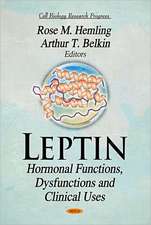A Systems Biology Approach to Advancing Adverse Outcome Pathways for Risk Assessment
Editat de Natàlia Garcia-Reyero, Cheryl A. Murphyen Limba Engleză Paperback – 29 ian 2019
| Toate formatele și edițiile | Preț | Express |
|---|---|---|
| Paperback (1) | 787.78 lei 6-8 săpt. | |
| Springer International Publishing – 29 ian 2019 | 787.78 lei 6-8 săpt. | |
| Hardback (1) | 1229.58 lei 6-8 săpt. | |
| Springer International Publishing – 7 mar 2018 | 1229.58 lei 6-8 săpt. |
Preț: 787.78 lei
Preț vechi: 960.71 lei
-18% Nou
Puncte Express: 1182
Preț estimativ în valută:
150.74€ • 157.81$ • 124.73£
150.74€ • 157.81$ • 124.73£
Carte tipărită la comandă
Livrare economică 05-19 aprilie
Preluare comenzi: 021 569.72.76
Specificații
ISBN-13: 9783030097585
ISBN-10: 3030097587
Ilustrații: XIV, 422 p. 77 illus., 64 illus. in color.
Dimensiuni: 155 x 235 mm
Greutate: 0.61 kg
Ediția:Softcover reprint of the original 1st ed. 2018
Editura: Springer International Publishing
Colecția Springer
Locul publicării:Cham, Switzerland
ISBN-10: 3030097587
Ilustrații: XIV, 422 p. 77 illus., 64 illus. in color.
Dimensiuni: 155 x 235 mm
Greutate: 0.61 kg
Ediția:Softcover reprint of the original 1st ed. 2018
Editura: Springer International Publishing
Colecția Springer
Locul publicării:Cham, Switzerland
Cuprins
1. Introduction.- Part I: Biology.- 2. "Non-model" species for eco and human health risk assessment.- 3.The fish embryo as a model for eco-toxicology and other potential models.- 4.Invertebrates/Plants.- 5.Behavioral/Neurobehavioral linkages to AOPs.- 6. Species extrapolation – common pathways etc.- 7. Life History Evolution, incorporating evolutionary processes into AOPs to extrapolate.- Part II: Incorporating Biology into AOPs.- 8.Use of HTS assays to infer MIEs.- 9. AOP development: how to infer and define KER.- 10. The development of quantitative AOPs.- Part IV: Incorporating Modeling into AOPs.-11.Computational approaches (network science, etc) in AOPs: linking molecular datasets.- 12.Computational approaches : Dynamic Energy Budgets.- 13. Modeling approaches in AOPs: extrapolation from individual to population.- 14. Modeling approaches that augment AOPs: GUTS, QSAR, TKTD PBTKTD.- 15. Exposure science and other stressors? How to incorporate.- 16. AOP as an organizing framework and implications for biological science-AOP evolution.- 17. Use and acceptance of AOPs for regulatory applications, use of AOPs in human risk assessment, and legislation.
Notă biografică
Natàlia Garcia-Reyero Vinas received her BS in Biology from Universitat de Girona, and her MS and PhD from Universitat de Barcelona, in Barcelona, Spain. She is now a researcher at the US Army Engineer Research & Development Center Environmental Laboratory. Her research focuses on environmental pollutants and their effects on aquatic species while trying to elucidate their mechanisms of action using ecotoxicogenomics and a systems biology approach.
Cheryl A. Murphy received her BSc in Marine Biology from Dalhousie University, Canada, her MSc in Physiology and Cell Biology from University of Alberta, Canada and PhD in Oceanography and Coastal Sciences from Louisiana State University. She is now an Associate Professor at Michigan State University, in the Department of Fisheries and Wildlife. Her research focuses on environmental pollutants and stressors and their effects on aquatic species while trying to link subtle molecular and subcellular responses to population relevant endpoints that are crucial for ecological risk assessment.
Textul de pe ultima copertă
Social pressure to minimize the use of animal testing, the ever-increasing concern on animal welfare, and the need for more human-relevant and more predictive toxicity tests are some of the drivers for new approaches to chemical screening. This book focuses on The Adverse Outcome Pathway, an analytical construct that describes a sequential chain of causally linked events at different levels of biological organization that lead to an adverse health or ecotoxicological effect. While past efforts have focused on toxicological pathway-based vision for human and ecological health assessment relying on in vitro systems and predictive models, The Adverse Outcome Pathway framework provides a simplified and structured way to organize toxicological information. Within the book, a systems biology approach supplies the tools to infer, link, and quantify the molecular initiating events and the key events and key event relationships leading to adverse outcomes. The advancement of these tools is crucial for the successful implementation of AOPs for regulatory purposes.
Caracteristici
First book to explore different aspects of systems biology and their application to the development of the adverse outcome pathway framework
Combines all computational and molecular tools together for applications
Bridges multiple scales of biological organization,beyond the organism to include population level effects
Combines all computational and molecular tools together for applications
Bridges multiple scales of biological organization,beyond the organism to include population level effects
























